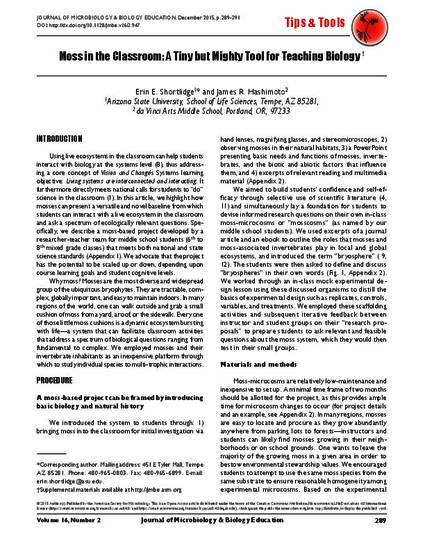
- Biology -- Study and teaching (Primary),
- Biology teachers,
- Mosses,
- Biology -- Research
Here we present a mechanism to infuse ecology into the classroom using a broadly adaptable system. We developed a novel moss-based project that introduces research-based experiences for middle school students, and can be modified for integration into K-16 classrooms. The project is ecologically relevant, facilliating opportunities for students to experience intimate interactions with ecosystem subtleties by asking their own questions. We describe and suggest how students can develop, build, test, and assess microcosm experiments of their own design, learning the process of science by “doing science.” Details on project execution, representative examples of distinctive research-question-based projects are presented. We aim for biology educators to adopt, replicate, modify, and formally assess this relatively simple, low-cost moss-based project across classroom levels. The project provides a chance for students to experience the complexity of a dynamic ecosystem via a research project of their own design as they practice basic tenets of scientific discovery.Editor's Note:The ASM advocates that students must successfully demonstrate the ability to explain and practice safe laboratory techniques. For more information, read the laboratory safety section of the ASM Curriculum Recommendations: Introductory Course in Microbiology and the Guidelines for Biosafety in Teaching Laboratories, available at www.asm.org. The Editors of JMBE recommend that adopters of the protocols included in this article follow a minimum of Biosafety Level 1 practices. Adopters who wish to culture microbes from the moss as an extension of this protocol should follow Biosafety Level 2 practices.

©2015 Author(s). Published by the American Society for Microbiology. This is an Open Access article distributed under the terms of the Creative Commons Attribution-Noncommercial-NoDerivatives 4.0 International license https://creativecommons.org/licenses/by-nc-nd/4.0/, which grants the public the nonexclusive right to copy, distribute, or display the published work.